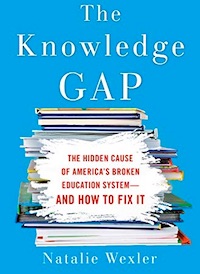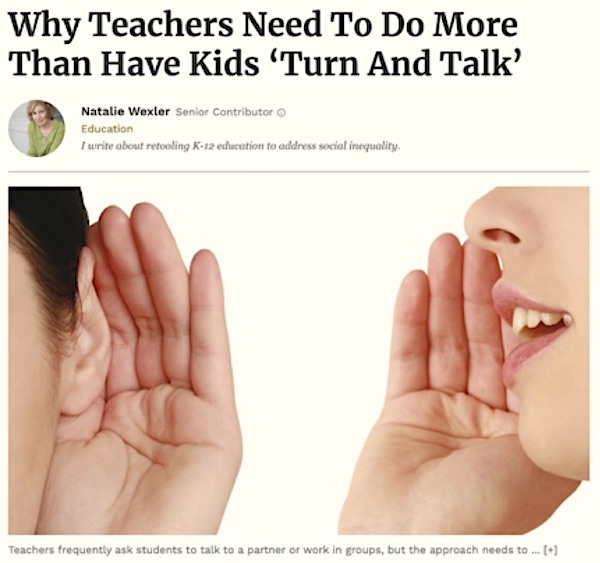 By Stoney M. Beavers
By Stoney M. Beavers
ABPC Assistant Director
Over the past decade we have seen a surging interest in having our students talk to each other about what they are studying. This shared dialogue, most educators might argue, is a great development and a move in the “right” direction to increase student engagement in the learning process.
 Natalie Wexler, author of The Knowledge Gap: The Hidden Cause of America’s Broken Education System – and How to Fix It, provides an opposing viewpoint in a recent column for Forbes. She argues that in many instances the use of the strategy may actually create “engagement without learning,” and calls for aligning the “Turn and Talk” strategy more closely with actual research in order to boost its effectiveness.
Natalie Wexler, author of The Knowledge Gap: The Hidden Cause of America’s Broken Education System – and How to Fix It, provides an opposing viewpoint in a recent column for Forbes. She argues that in many instances the use of the strategy may actually create “engagement without learning,” and calls for aligning the “Turn and Talk” strategy more closely with actual research in order to boost its effectiveness.
In our work with educator networks across the state, the Alabama Best Practices Center uses several “turn and talk” strategies during our professional learning experiences with teachers and leaders. They are part a “toolbox” of learning protocols that encourage participants to share what they know or wonder and to process and evaluate new ideas in small groups.
In my past experiences as a network participant, our ABPC protocols provided the reflection, writing, and context that Wexler finds lacking in the way she believes “Turn and Talk” is typically used in classrooms. I asked my colleague Cathy Gassenheimer – who helped developed our protocols with ABPC primary consultant Jackie Walsh – to share more about this:
CATHY: Intentionality is the key to any process that involves student (or teacher learner) talk. Creating norms of participation, such as: listen actively, focus on the learning task at hand, allow think time before and after speaking, and being open to and respectful of all points of view, can help ensure productive and meaningful learning. We also like to give students/participants roles in collaborative learning – ranging from facilitator to recorder/reporter, time keeper, and materials manager.
Above all, it is critically important that the teacher or PD facilitator is clear about the purpose of the collaborative learning and what students/participants are expected to do and learn. For students, a turn and talk process might require students to jointly craft a response to a question, surface misunderstandings, or develop a question related to the specific learning at hand. Purpose is absolutely key.
Wexler’s article can provide some thought-provoking ideas for making sure we build in clear guidelines for “Turn and Talk.” She is not dismissing small group discussion but suggesting ways that the strategy can boost learning along with engagement. Readers can extend their own learning by exploring how the strategy could incorporate debate and negotiation, metacognitive reflection, and even social and emotional skills.
Wexler also hits on the urgent need to expand student writing when she suggests that some “Turn and Talk” activities might be more beneficial to learners if they were re-cast as “Reflect and Write” activities, possibly then followed by a “Turn and Talk.”
Her article may challenge our thinking, but it can also provide us with some powerful reflection points to consider for future implementation.
Click to read Natalie Wexler’s complete article
(To read Wexler’s ideas about reading comprehension, see this MindShift article)


0 Comments on "Are We Using “Turn and Talk” to Promote Learning As Well As Engagement?"